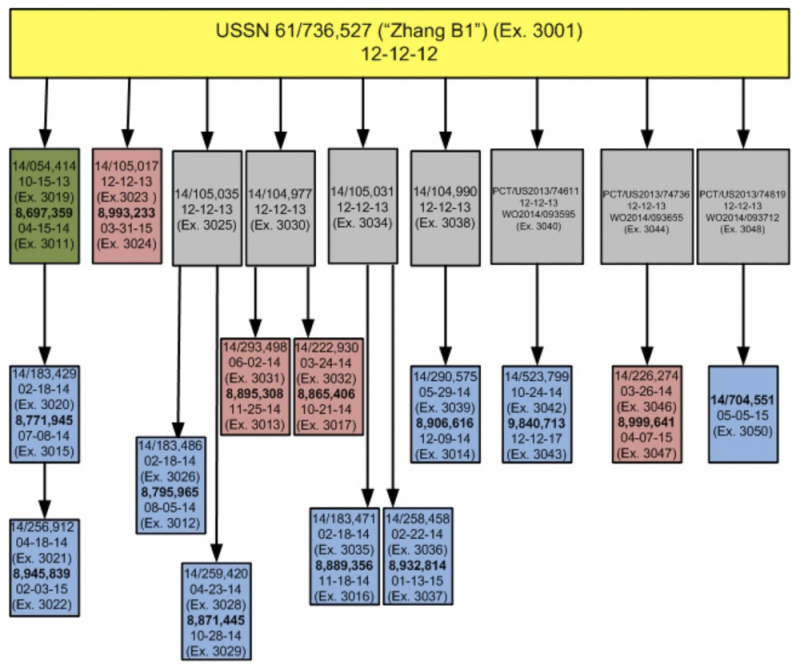On October 14th, Senior Party the Broad Institute (joined by Harvard University and MIT) filed several authorized motions in Interference No. 106,115, including Substantive Motion No. 2 and No. 3, against Junior Party the University of California, Berkeley; the University of Vienna; and Emmanuelle Charpentier; collectively, "CVC." In its Motion No. 4, the Broad asks the U.S. Patent and Trademark Office Patent Trial and Appeal Board for priority to U.S. Provisional Application No. 61/736,527 to Zhang (termed "Zhang B1" in the motion), pursuant to 37 C.F.R. §§ 41.121(a)(1)(ii) and 41.208(a)(3) and Standing Order ¶ 208.4.1.
The brief begins by setting forth the standard for obtaining the relief requested: "a party need only show a constructive reduction to practice—an enabled written description—of a single species within the count," citing Hunt v. Treppschuh, 523 F.2d 1386, 1389 (CCPA 1975); Weil v. Fritz, 572 F.2d 856, 865 n.16 (CCPA 1978); and Falkner v. Inglis, 448 F.3d 1357, 1362 (Fed. Cir. 2006). For completeness, the brief sets forth the standard for constructive reduction to practice under 37 C.F.R. § 41.201. According to the Broad, Zhang B1 "provides working examples and embodiments that meet each and every limitation of both halves of Count 1" and thus evinces to the skilled worker possession of an embodiment within the scope of the Count.
The brief includes a schematic of the relationship between Zhang B1 and the multiple patents and applications claiming priority thereto:

These priority relationships are claimed in each link in the priority chain, according to the Broad, with reference to more than a dozen facts set forth in the Appendix of material facts. While admitting that the priority claim is set forth in each in "boilerplate language" (perhaps anticipating CVC's objection), the brief asserts that "[t]he PTAB has held that such 'boilerplate language' . . . broadly stating without further qualification that the earlier-filed patents are 'incorporated by reference,' is sufficient in view of Federal Circuit precedent to incorporate the disclosure of at least the [earlier filed] patent into each later-filed patent," citing Symantec Corp. v Finjan, Inc., 2016 WL 1081973 (IPR2015-01897 (PTAB February 26, 2016)) (citing Harari v Lee, 656 F. 3d 1331, 1335 (Fed. Cir. 2011). Further support is asserted by the Broad because Example 1 from Zhang B1 is explicitly disclosed in Broad's involved U.S. Patent Nos. 8,771,945; 8,795,965; 8,871,445; 8,889,356; 8,932,814; 8,945,839; 8,906,616 and 9,840,713, as well as the Broad's involved U.S. Patent Application No. 14/704,551. Other patents in the priority chain incorporate Zhang B1 by reference. The brief then asserts that the priority claim in each case complied with the requirements of 35 U.S.C. § 120.
Turning to Example 1 of Zhang B1, the brief sets forth the argument for Zhang B1 satisfying the requirements for constructive reduction to practice, including the level of one of ordinary skill in the art and how Example 1 would be understood by such a person (in detail). According to the Broad, "Zhang B1 sufficiently teaches, describes and enables each embodiment such that [a person having ordinary skill in the art would be able to use each embodiment successfully, without undue experimentation, and hence provides systems, cells, and methods falling within the scope of Count 1." The brief characterizes as "the Broad half of the Count" the alternative recited in the Broad patent used as the exemplar of the Count and recites with reference to the specification the disclosure in Zhang B1 disclosing these elements. The brief supports these explications of the Zhang B1 disclosure with expert affidavit testimony. The brief then sets forth disclosure in Zhang B1 of the elements defined by the "CVC half of the Count," the alternative recited in the CVC application used as the exemplar of the Count.
The brief then turns to enablement, focused on the "working examples" of CRISPR-Cas9 set forth in Zhang B1, including disclosure of utility in eukaryotic cells for the disclosed technology.
Accordingly, the brief asks the Board to grant priority to Zhang B1, giving the Broad a presumptive priority date of December 12, 2012.